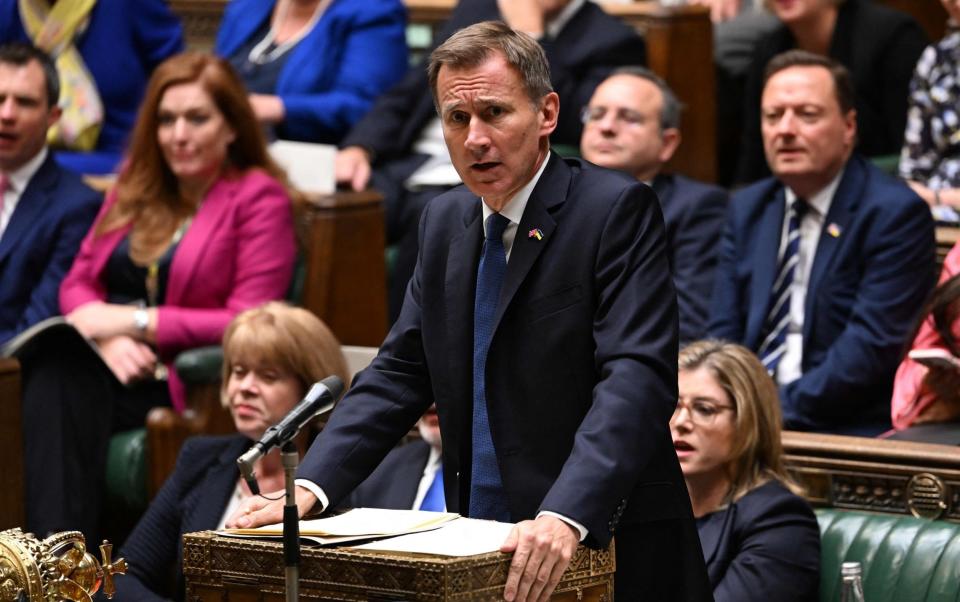How much will the triple lock increase my state pension, and is it under threat?

Millions of state pensioners will receive the biggest pay rise on record this spring, but the future of the Government’s controversial “triple lock” remains uncertain.
The policy, which was a key Conservative manifesto pledge in the last election, promises to increase the state pension every April in line with the highest out of the previous September’s Consumer Price Index measure of inflation (CPI), wage growth or 2.5pc.
It means that the full new state pension will rise to £203.85 per week, equivalent to £10,600.20 a year, from April. It will be the first time that the state pension has ever exceeded £10,000, and will be £972 higher than the previous tax year.
The basic state pension, paid to those who reached the state pension age before 2016, will increase to £156.20 a week or £8,122.40 annually.
But this bumper pay rise will come at a massive cost to the Government. At a time of mounting political pressure to get public finances under control, the state pension triple lock has become a key area of debate. Nearly half of retirees rely on the state pension as their main source of income, according to pension provider Royal London.
Is my state pension under threat?
The triple lock is not written into law, so it can be changed. During the pandemic the Government broke the earnings link of the triple lock, and instead chose to uplift pensions in line with inflation at 3.1pc. This was because the pandemic furlough scheme and redundancies led to a freak 8.3pc jump in wage growth.
But even before then, the Government has long been aware of the pressure that the policy would face. Helen Morrissey, of the broker Hargreaves Lansdown, said: “In 2017, a government-backed review found that while the state pension was doing a great job at boosting pensioner income, there would come a point when it becomes intergenerationally unfair.”
The state pension system is funded on a pay-as-you-go basis by taxes collected from today’s workers and businesses. Critics of the triple lock have suggested it is unfair that workers are footing the bill of such a large pay rise for retirees.
The upcoming 10.1pc rise is expected to cost the Government an additional £11bn in April, according to estimates from the Institute for Fiscal Studies, a think tank.
Such a large bill has given rise to doubts even within the Conservative Party. Former Tory chancellor Philip Hammond questioned the sustainability of the triple lock in an interview late last year.
“Is it really right that we should always up the rate by the highest of wages, prices or by 2.5pc?” he asked.
“I think that is quite difficult to justify, and not all pensioners are poor. So I think there is a case for looking again at the way we treat pensioners, and possibly for distinguishing the poorest pensioners from the great body of pensioners, some of whom are really quite comfortably off.”
The International Monetary Fund expects inflation to average 9pc in Britain over the next year, which could compel the Government to spend billions more on state pension payments yet again in the 2023-24 tax year.
However, the Government has so far been reluctant to commit to any reform, especially as the policy helps curry favour with older voters.
The current Chancellor, Jeremy Hunt, said in his Autumn Statement: “The cost of living crisis is harming all pensioners...we will fulfil our pledge to the country to protect the pensions triple lock. To the millions of pensioners who will benefit from this measure, I say now and always, this Government is on your side.”

Is it really unsustainable?
But policy experts are scratching their heads. Pensioner benefit spending in 2022-23 represented just over a tenth of total public spending and 5.5pc of GDP, according to the Office for Budget Responsibility.
The state pension is one of the most expensive policies in Government. This makes it a big target for reform, especially as Britain’s official actuary has warned that the Government will soon spend more on the state pension and other benefits than it collects from National Insurance payments.
Contrary to popular belief, there is no National Insurance “fund”. Pensions and other benefits are funded by taxes collected from today’s workers. However, the actuary’s department has warned that the National Insurance “deficit” was forecast to rise to £9.7bn in the 2025-26 tax year and then to £9.4bn in 2026-27.
If it continues to deteriorate, the Treasury could be compelled to step in. A Treasury grant is a payment voted by Parliament. It is typically paid if the balance is projected to fall below one sixth of the forecast annual expenditure on benefits, or 16.5pc. The current balance stands at 51.9pc, but is forecast to more than halve to 24.1pc by the 2027-28 tax year.
Experts have warned uncertainty still lies ahead for future retirees. Mr Hunt said the Government would publish its review into the state pension age early this year, as expectations rise that it could increase to 70 sooner than expected. Plans are already in place to increase the state pension age to 68 between 2044 and 2046 for those born on or after April 1977.
Increasing the state pension age is a seemingly straightforward way for the Treasury to save tens of billions of pounds. It will push down the cost of the state pension, as well as generate more revenue in income tax from people who have no choice but to stay in the workforce for longer.
However, history suggests that increasing the state pension age deepens social inequality across the country. When the state pension increased from 65 to 66, one in seven 65-year-olds were pushed into income poverty as a result, the IFS estimated.
In the most deprived 20pc of areas in England, there was an 11 percentage point increase in the number of over-65s returning to work. That was more than double the wealthiest 20pc of areas, which recorded a rise of just four percentage points.
It could take both an increase in the state pension age and reform of the triple lock policy to balance the impact on both public spending and social welfare.
So what would a new state pension policy look like?
A “double lock” or “smoothing average” of the triple lock are frequently discussed alternatives.
Baroness Ros Altmann, a former pensions minister, said: “It is clear that the 2.5pc part of the triple lock has become redundant, but in the long-term fiscal accounts this part adds significantly to the forecast cost of state pensions in the future. It has no economic logic to it and was put in as a political decision.
“The triple lock has become a totemic symbol of government commitment to pensioners, but since the new state pension began, it seems to make much less sense from a social perspective.”
Baroness Altmann suggested a “double lock” policy might be more suitable.
“A double lock on all parts of the state pension, paying the best of earnings or price inflation might be fairer and making tax free benefits such as the Winter Fuel Payment taxable could help reduce the costs,” she said.
An alternative “smoothing” process could improve the policy's sustainability, so that the state pension increases by the average of inflation, wage growth and 2.5pc, rather than the highest of the three.
If the policy had been implemented in this shape since its introduction in 2011, it would have saved the Government approximately £13.4bn, according to calculations from the pensions specialist Canada Life.
How can I qualify for the full £10,600 this April?
In order to qualify for a full state pension, you must have a 35-year record of National Insurance Contributions or received National Insurance credits for raising children or providing care. You need at least 10 years in total on your National Insurance record to receive any state pension.
Each individual’s state pension payments can look different depending on when they were born and how long they worked, as well as if they took any career breaks.
You can help your state pension grow by applying for National Insurance credits. These fill the gaps in your NI record and can apply to a range of periods such as being on jobseeker’s allowance, maternity allowance or even being on a government-approved training course.
Your full state pension will also look different depending on when you were born. Those who reached retirement age before 2016 will be entitled to the basic state pension, also known as the “old” state pension.
There is a gap between the old and the new state pension because retirees on the former were entitled to an additional “state earnings-related pension scheme” known as Serps.

 Yahoo Movies
Yahoo Movies 
